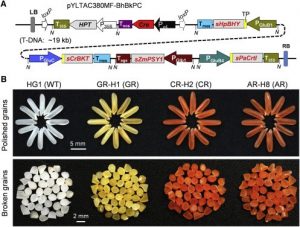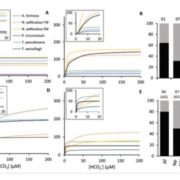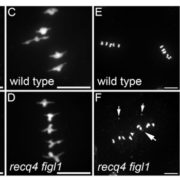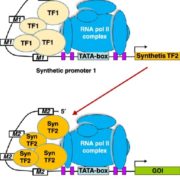From Golden Rice to aSTARice: Bioengineering astaxanthin biosynthesis in rice endosperm (Molecular Plant)
 Zu et al., have successfully harnessed the power of synthetic biology to increase the nutritional content of rice by overexpressing only four synthetic genes in rice endosperm. Here, the authors have created a colorful gradient of carotenoid-enriched rice by expressing two, three, and then four genes involved in astaxanthin synthesis. Overexpressing phytoene synthase and phytoene desaturase in white indica rice produced yellow-grained Golden Rice. Adding a third gene, β-carotene ketolase, resulted in orange-red-grained Canthaxanthin Rice and finally a fourth gene for β-carotene hydroxylase produced red-grained Astaxanthin Rice (aSTARice). The carotenoids in these engineered endosperms all have excellent antioxidant properties. Astaxanthin is a particularly strong antioxidant and is not produced in most higher plants. This carotenoid is commercially valuable for use in pharmaceuticals, nutraceuticals, cosmetics, and the aquaculture industry. We typically consume astaxanthin when we eat seafood, such as salmon, shellfish, and trout. This new type of rice could provide a new way to introduce astaxanthin into our diets.
Zu et al., have successfully harnessed the power of synthetic biology to increase the nutritional content of rice by overexpressing only four synthetic genes in rice endosperm. Here, the authors have created a colorful gradient of carotenoid-enriched rice by expressing two, three, and then four genes involved in astaxanthin synthesis. Overexpressing phytoene synthase and phytoene desaturase in white indica rice produced yellow-grained Golden Rice. Adding a third gene, β-carotene ketolase, resulted in orange-red-grained Canthaxanthin Rice and finally a fourth gene for β-carotene hydroxylase produced red-grained Astaxanthin Rice (aSTARice). The carotenoids in these engineered endosperms all have excellent antioxidant properties. Astaxanthin is a particularly strong antioxidant and is not produced in most higher plants. This carotenoid is commercially valuable for use in pharmaceuticals, nutraceuticals, cosmetics, and the aquaculture industry. We typically consume astaxanthin when we eat seafood, such as salmon, shellfish, and trout. This new type of rice could provide a new way to introduce astaxanthin into our diets.
Our Tweet of this publication was retweeted 47 times and received 79 likes November 2018. (Summary by by Katie Rogers, https://doi.org/10.1016/j.molp.2018.09.007 )








